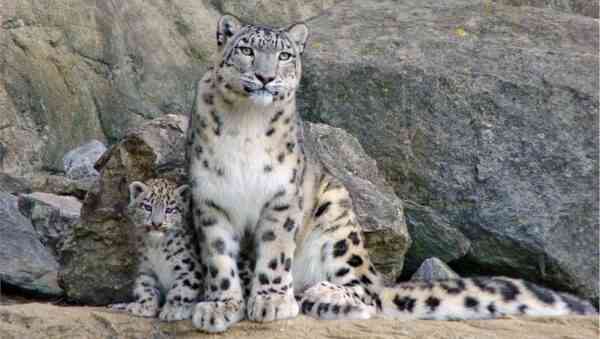Powerful and hardy snow leopards, also called irbis, live quietly where most other representatives do not survive cat families. Nature rewarded them with thick fur that reliably protects from frost, sharp teeth, powerful paws and developed intelligence, so in the wild this predator has almost no enemies, except perhaps for people.
Interesting facts about snow leopards
- These big cats are still rather poorly studied, because they live mainly in remote areas.
- The weight of an adult snow leopard can reach 55 kg, and the body length including the tail exceed 2 meters.
- Unlike the Amur tiger, the snow leopard’s spots on the skin are not solid, but rather ring-shaped (interesting facts about the Amur tiger).
- Snow leopards are threatened with extinction, despite the fact that hunting for them is strictly prohibited. Around the world, according to various estimates, from 3 to 7 thousand snow leopards remain. They are included in the international Red Book.
- Judging by archaeological finds, snow leopards lived on Earth already 1.2-1.4 thousand years ago. It is this age that their fossilized remains found in Pakistan date back to.
- Snow leopards can purr like ordinary domestic cats. But, on the contrary, they do not know how to growl.
- The snow leopard kittens brought up from childhood quickly get used to humans and become tame.
- Irbis rarely hunt mice and hares, preferring larger prey. Often his prey outnumber him.
- Leopards are often called leopards, therefore, because of the external similarity, snow leopards began to be called snow leopards (interesting facts about leopards).
- To shelter from bad weather, snow leopards usually arrange dens in caves and clefts of rocks.
- The long and thick tail of the snow leopard serves as a rudder and counterweight, helping to maintain balance while jumping.
- Male leopards are usually a third larger than females.
- Thanks to their broad paws, snow leopards can walk calmly even on loose snow without falling into it.
- Females nursing kittens wrap them with their fluffy tail to protect them from the cold.
- Snow leopards can jump 6-8 meters from a running start.
- Irbis prefer to live in the mountains, at an altitude of several kilometers. So, in the Himalayas, they are sometimes found at an altitude of 5-5.5 km.
- The hard bumps that dot the surface of the snow leopard’s tongue help them to easily separate the meat from the bones.
- The females of these big cats give birth every 2 years, usually giving birth to 2-3 kittens. They spend the first two years of their lives with their mother, and then leave.
- Irbis are the only cats on the planet that live so high in the mountains.
- Extremely sharp eyesight allows them to see white prey on white snow from a distance of several kilometers.
- From the point of view of biology, the closest relative of the snow leopard is the tiger (interesting facts about tigers).
- In captivity, snow leopards live for 20 years, and in the wild – for 11-12. The officially registered longevity record is 28 years.
- Irbis never attack people. Why is unknown, although, of course, it is for the best.
- They are predominantly nocturnal, preferring to sleep in a safe shelter during the day.
- October 23 is considered International Snow Leopard Day.
- Unlike most other felines, snow leopards have round pupils, not vertical ones.
- Despite the fact that each male snow leopard has «his» territory, he will not show aggression when he meets another male on it.
- The paw pads of the snow leopard are covered with hair, like a lynx. This also helps him not to fall into the snow (interesting facts about the lynx).
- The length of the irbis tail is comparable to the length of its entire body.
- Among all land predators, the snow leopard is the most secretive, and that is why it is so poorly studied.
- Snow leopards spend their entire lives alone, and males meet with females only during a short mating season. The male does not take part in the fate of the offspring, placing all responsibility on the female.
- The word «irbis» translated from one of the Turkic languages means «snow cat».
- Snow leopards are not alien to fun. Researchers have seen them ski down snow-covered slopes while lying on their backs, and then repeat this activity for no purpose, just for fun.
